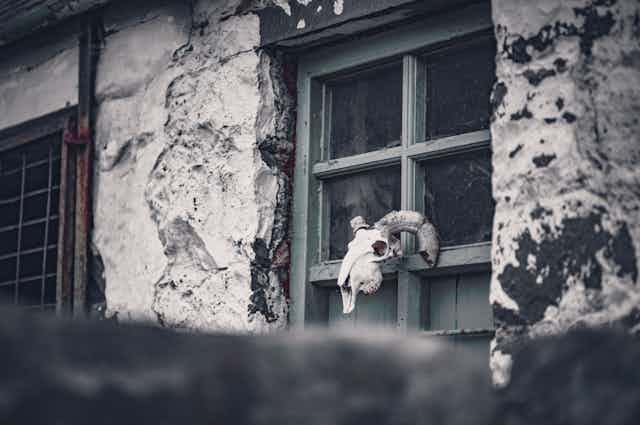Children throughout Wales will be dressed in witch or ghost costumes come October 31, going from door to door, chorusing “trick or treat” in the hope of receiving sweets. In other words, the scene will be very much like that encountered at Halloween in the rest of the UK.
On posters advertising Halloween events in Wales, the word Halloween is rendered in Welsh as Nos Galan Gaeaf. A common complaint is that traditional customs at this time of year have been eclipsed by an increasingly homogenised and commercialised event imported from the USA.
But how would Welsh people have celebrated Nos Galan Gaeaf in former centuries? What is its origin? And has it always been intrinsically linked to Halloween?
October 31 celebrations
Halloween has its origins in AD609 or AD610 when the Pantheon in Rome was converted to a place of Christian worship and dedicated to Mary and to all the martyrs by Pope Boniface IV, who ordered an anniversary to be celebrated.
In the eighth century, the date of the celebration at the Basilica of St. Peter was fixed on November 1. This was extended by Gregory IV in the early ninth century to the whole church.
This celebration was known in English as “All Hallows Day”, and thus the eve is Halloween. It is quite plausible that there was already a seasonal festival of some sort at this date and that some of the features of this festival were transferred to Halloween.
A common claim is that Halloween is essentially Celtic. It is true that Gaelic-speaking places (Ireland, Gaelic Scotland and the Isle of Man) celebrated, at this time, a festival called Samhain, references to which abound in early medieval Irish literature. It was presented as a time of uncanny events and otherworldly visitations.
The name Samhain is often mispronounced by non-Gaelic speakers as “Sam Hain”. But it is actually closer, in modern Irish pronunciation, to “sow won” (sow as in female pig).
However, while Welsh is also a Celtic language, there is no evidence for Samhain having been celebrated in Wales – so, it could well be a Gaelic rather than a Celtic institution. The oft-repeated claim that it signifies the start of the Celtic year is based on the speculation of comparative mythologists.
The name Nos Galan Gaeaf certainly does not go back to a prehistoric period of Celtic linguistic unity. The word calan is borrowed from the Latin calends, meaning “the first day of the month”, while gaeaf means “winter”.
So we can think of it as “the winter calends”, or “the first day of winter”. Calan was one of hundreds of Latin loan words that entered the Brittonic language, the ancestor of the Welsh language, during the period in which Britain was part of the Roman Empire.
There is, however, an element of the name which does have Celtic ancestry. Calan Gaeaf on its own is November 1, but Nos Galan Gaeaf (the “night of the winter calends”), is the night before.
Julius Caesar said of the Celtic-speaking Gauls (who inhabited what is now France and Belgium), that they counted the day to begin on the previous evening. This is reflected in medieval Irish, where the term aidche Lúain means “the night before Monday” – what we would call Sunday night. This is merely a linguistic fossil, however, and does not prove anything about the antiquity of Nos Galan Gaeaf.
There are medieval references to it, for example, in poetry from the Black Book of Carmarthen, a collection of early Welsh poems and manuscripts. Calan Gaeaf is also mentioned in the early Welsh laws, detailed in 13th-century manuscripts, but those references are disappointingly prosaic.
And, it is only in the modern period that we have references to Nos Galan Gaeaf customs, exhaustively catalogued in the 20th century by the historian, Trefor M. Owen.

Spooky customs
How people celebrated varied significantly from region to region. Many, such as bobbing for apples, and various types of divination to determine who will marry who, are far from unique to Wales. Nonetheless, some have an unfamiliar twist.
In south Wales, parties of young people would maraud from door to door like modern trick or treaters. In Glamorgan, boys would wear women’s clothing. Much more sinister were the gwrachod (meaning “witches” or “hags”) of Powys though. These were men who would go about in pairs, dressed as an old man and old woman, or in gangs dressed in sheep skins and masks, drinking heavily and demanding gifts.
The lighting of a bonfire, or coelcerth, was a notable feature too. Close to the fires, people would be safe from wandering spirits, but the return home could be a fraught business. In the darkness lurked the Hwch Ddu Gwta (tail-less black sow) accompanied by the Ladi Wen heb ddim pen (the white lady without a head).
If you want to stand out from the crowd of mummies and vampires this October 31, you could do worse than dressing as one of these gruesome characters instead.

